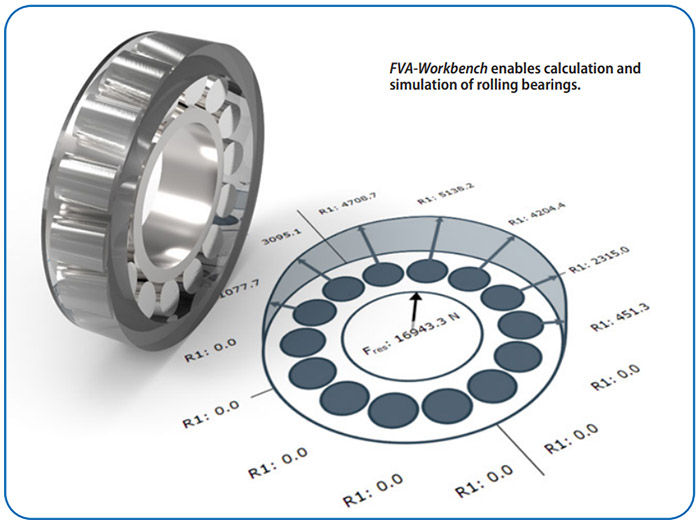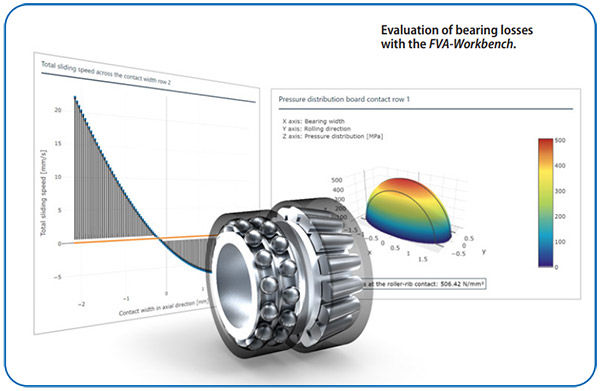The foundation of the methodology is a precise resolution of the rolling contacts in the bearing, the tribological characterization, and the allocation of the loss components to the loss mechanisms. The total power loss is the sum of the individual losses in the bearing. The following individual friction components are considered: the hydrodynamic rolling friction Mhydr, hysteresis friction Mirr, splash losses MPlansch, differential slip MDiff, and the rib friction MBord. Friction from cage contact and seals is neglected. This results in the following general relationship:
The geometries of the rolling bearings are needed to calculate the contacts. The Breuer calculation approaches from FVA 184 are used to determine the internal load distribution on the rolling elements and the pressure distribution on the rollers. Thus, all influences from the gear system are fully considered (Ref. 4).
Different contacts and loss mechanisms occur in different rolling bearing designs. Formula (1) must be modified to take this into account. The ribs of deep groove ball bearings and angular contact ball bearings are ignored due to their design. For cylindrical roller bearings, on the other hand, the differential slip is ignored; however, if the bearing type has ribs, the rib friction is considered.
The calculation of the hydrodynamic rolling friction is based on the EHD theory. For this purpose, the bearing pressure across the contact length and contact width are resolved. The rolling element pressure can be derived from the stiffness calculation. All load components are considered in the stiffness calculation. The losses from irreversible deformation are determined by the material characteristics of the rolling bearings. The material damping influences the extent to which the irreversible deformation contributes to the total losses.
FVA-Workbench enables calculation and simulation of rolling bearings.
The splash losses in the rolling bearings are taken into account by many different influences. For a fast and powerful calculation, a CFD calculation is only of limited use. Therefore, the splash losses are determined based on the measurements from FVA 352. The losses can be derived from these measurements, depending on the oil level in the bearing and the bearing geometry.
With grease lubrication, splash losses are neglected. This is based on the assumption that the grease was completely pushed out of the contact during the first revolutions of the bearing. The contact is supplied with the base oil viscosity by a lubricant. Thus, splashing cannot occur.
For bearings with point contact, the differential slip must also be considered. In addition to the more obvious deep groove ball bearings and angular ball bearings, this also occurs in tapered roller bearings with rib contact. The Heathcote effect and the bore movement that results if a rolling element runs on a raceway with an operating pressure angle other than 0° are considered in this calculation.
The validation projects of FVA 364 IV and FVA 701 show an excellent accordance with the theory. Thus, significantly higher accuracy can be achieved compared to the factor-based catalog methods. These high-quality results are achieved by completely considering the pressure distribution and the environmental boundary conditions, such as tilting and bearing clearances.
The FVA-Workbench Brings Theory into Practice
In practice, precise statements regarding losses in the drive are required as early as the project planning phase. Every bearing and every auxiliary drive counts. With the new statements from FVA 701 I and III, manufacturers can now provide these statements and prove them with investigations from joint research. The FVA-Workbench supports engineers with an easy-to-use calculation model, comprehensive input consistency checks, and easy-to-interpret results. With the results from FVA 701 II, gearbox manufacturers are now able to provide reliable statements regarding losses in the offer phase and better describe the loss mechanisms.
Evaluation of bearing losses with the
FVA-Workbench
FVA-Workbench — The Simulation Tool for Efficient Gear Design
The FVA-Workbench is a manufacturer-neutral software solution for the modeling, parameterization, and calculation of transmission systems. It bundles 50 years of research and development from the FVA expert network into a single platform and makes this accumulated knowledge directly available for industrial application. The software includes an impressive scope of calculations for all phenomena relevant to the design of drive systems. Gearbox systems can be developed in shorter cycles and in leading quality.
Seminars on the Cutting Edge of Research
For detailed insight into damage mechanisms and how loss calculation plays a decisive role, FVA Software and Service GmbH regularly offers seminars with well-known experts on the subjects of gearbox calculation and rolling bearing damage. In these seminars, you will learn about what makes a good design, how damage occurs, and how it can be avoided. At the same time, you can also make contact with FVA experts and other participants with similar interests.
For more Information
www.fva-service.de.
- Forschungsvereinigung Antriebstechnik e.V. 2018 Annual Report
- FVA 364 IV - Service Life - Industrial Gear Units - Rolling Bearings (Lager2 extensions)
- FVA 382 - Influence of the Oil Level on the Friction Moment of Rolling Bearings with Line Contact
- www.fva-service.de/en/fva-workbench/features/overall-system-calculations/








